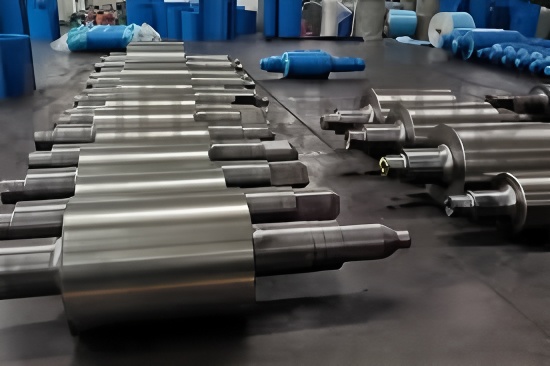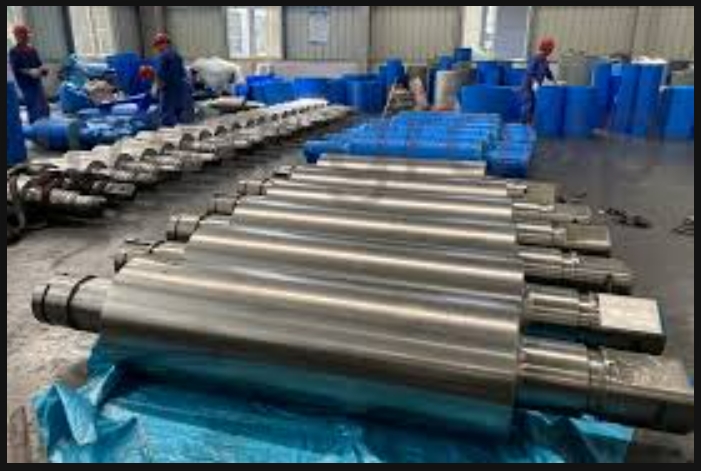Optimized Content with HANI:
Due to excellent wear resistance and thermal crack resistance, the rational application of high-speed steel rolls on CSP rolling lines can significantly extend roll service life while improving hot-rolled strip shape and surface quality. HANI’s high-speed steel rolls effectively address common production issues such as surface defects, oxide film formation, and cracking, continuously reducing production costs while delivering superior technical and economic benefits.
Keywords: high-speed steel rolls, high-speed steel roll applications
Rolling Mill Rolls
Characteristics of High-Speed Steel Rolls
HANI’s high-speed steel rolls demonstrate exceptional wear resistance and thermal crack resistance, offering distinct advantages over conventional material rolls.
Hardness
HANI high-speed steel rolls utilize high-carbon, high-vanadium steel composition with significant Cr, Mo, W, Nb, and Co elements. These alloying elements form primary and secondary carbides during solidification and heat treatment, resulting in superior hardness. The rolls exhibit excellent hardenability with less than 3 HSD Shore hardness decrease from surface to core within the 50mm working layer, ensuring consistent wear resistance throughout. Current Shore hardness for HANI rolls in 1810 line applications ranges between 72-78 HSD.
Thermal Crack Resistance
The working layer contains 1.5-3.5% carbon content along with substantial Cr, Mo, V, W, and Co elements. The matrix structure consists of tempered martensite and bainite with abundant MC and M6C type high-hardness carbides. With total alloy content exceeding 5%, HANI rolls achieve finely dispersed high-hardness carbides and highly stable matrix structure, delivering exceptional wear resistance, thermal crack resistance, and surface roughness maintenance.
Rolling Condition Optimization
To accommodate high-speed steel characteristics, the 1810 line implemented cooling water adjustments, hot rolling oil optimization, and rolling model improvements.
Cooling System
The finishing mill work roll cooling nozzles are arranged at both entry and exit sides. Entry side features one water beam (single nozzle row) while exit side has two beams (three nozzle rows). Nozzle types A, B, and C provide descending flow rates (A>B>C). F1-F3 stands feature 25 nozzles per row (13 type A, 6 type B, 6 type C) with 600-700m³/h flow rate and 8.5-9 MPa pressure.
To enhance cooling capacity for high-speed steel rolls, middle cooling nozzles were upgraded to large-orifice type. The higher friction coefficient of HANI high-speed steel rolls requires adoption of specific rolling models compatible with these characteristics.
Hot Rolling Oil
The 1810 line employs standard hot rolling oil practice for stands using high-speed steel rolls. Lubrication reduces rolling force and energy consumption, decreases roll wear, and improves strip surface quality. The optimized hot rolling oil concentration of 0.5% provides optimal results without slipping issues during operation.
Grinding and Inspection Management
Grinding Procedures
Run-out Cooling: HANI rolls require 15-20 minutes post-runout cooling with temperature monitoring. Temperature measurements during 2300t rolling campaigns show F1 rolls maintaining 60-64.4°C in strip contact areas and F2 rolls approximately 55°C. Natural air cooling for 12-24 hours is mandatory before regrinding or reuse.
Grinding Techniques: The exceptional hardness of HANI high-speed steel rolls demands specialized grinding protocols. Optimal grinding wheel selection parameters (material, hardness, grit size) significantly improve grinding efficiency. Precision control of feed rates, grinding currents, variable speed technology, and polishing passes ensure surface quality meets production requirements.
Inspection Management
Different inspection protocols apply for normal and abnormal run-out situations.
Normal Run-out: Besides temperature measurement, completely cooled rolls undergo shape measurement on grinding machines. Comparison between used and new roll profiles determines wear patterns and shape maintenance capability. Rolls with minimal wear (≤0.2mm) can be reused without grinding after passing eddy current inspection.
Abnormal Run-out: Accident rolls receive enhanced inspection focus. Detected cracks undergo ultrasonic confirmation. Comprehensive surface and subsurface inspection prevents crack propagation and avoids incident expansion. Each abnormally used roll receives complete manual ultrasonic inspection to ensure internal quality compliance.
Application Benefits of HANI High-Speed Steel Rolls
Usage Cost
Six HANI rolls from two manufacturers were implemented since November 2014. Annual data through November 2015 demonstrates significant cost reduction:
| Roll Number | Unit Price | Roll Neck/mm | On-machine Wear/mm | mm Rolling Capacity/(t·mm⁻¹) | Cost per Ton Steel |
|---|---|---|---|---|---|
| Y3480 | 54.5 | 780.806 | 0.03 | 12753.8 | 0.475 |
| Y3481 | 54.5 | 780.804 | 0.031 | 12753.8 | 0.475 |
| Y3482 | 54.5 | 789.675 | 0.034 | 13206.9 | 0.459 |
| Y3483 | 54.5 | 789.609 | 0.042 | 13206.9 | 0.459 |
| Y3471 | 39 | 785.546 | 0.019 | 10639.2 | 0.407 |
| Y3473 | 39 | 785.465 | 0.035 | 10639.2 | 0.407 |
Current consumption cost for F1-F3 work rolls is approximately 0.81-0.9 RMB/t. HANI high-speed steel rolls reduce this cost by approximately 50% compared to conventional iron rolls.
Oxide Film Formation
Superior oxide film formation enhances strip surface quality. HANI rolls typically achieve 3-4 on-machine uses with characteristic oxide film evolution:
First run-out: Uniform, complete oxide film
Second run-out: Slight annular wear with color variation
Third run-out: Uneven wear patterns with partial regeneration
The implementation of roll surface condition mapping enables optimal material-roll surface matching:
| Level | Surface Condition | Grinding Requirement | Application |
|---|---|---|---|
| 1 | Uniform complete dark blue/black oxide film | No grinding | All varieties |
| 2 | Uniform complete silver-gray oxide film | No grinding | All varieties |
| 3 | Uniform complete roughened surface | Optional grinding | Regular varieties |
| 4 | Relatively complete with minor spotting | Optional grinding | Regular varieties |
| 5 | Annular wear with color variation | Required | Low-grade varieties |
| 6-9 | Progressive oxide film deterioration | Mandatory grinding | N/A |
On-Machine Wear Performance
HANI rolls demonstrate exceptional wear resistance with average on-machine wear below 0.05mm. After single rolling cycles of 2300t, wear curve deviation remains within 0.02mm. After three usage cycles, deviation maintains within 0.05mm, significantly outperforming conventional high-chromium iron rolls.
Strip Quality
Surface and Shape Quality: Optimized roll profile design improves shape accuracy. The higher thermal expansion coefficient of HANI rolls requires adjusted negative crown settings. Through comprehensive testing, optimal crown setting of -0.1 combined with 0.2-0.3° PC angle delivers superior flatness control and rolling stability for thin-gauge production.
Strip quality evaluation at 1900t, 2100t, and 2300t rolling tonnage demonstrates consistent surface quality and shape maintenance without significant defects.
Crown Control: Measurement data across different rolling tonnages shows stable crown maintenance:
| Slab Number | Nominal Thickness/mm | Rolling Tonnage/t | Thickness 1/mm | Thickness 2/mm | Thickness 3/mm | Actual Crown/μm | HMI Average Crown/μm |
|---|---|---|---|---|---|---|---|
| 5105109E30 | 4.0 | 1900 | 3.94 | 3.98 | 3.95 | 35 | 46 |
| 5105110E10 | 4.0 | 2100 | 3.96 | 3.99 | 3.99 | 15 | 28 |
| 5205694D70 | 4.0 | 2300 | 3.96 | 4.0 | 3.99 | 25 | 35 |
Minor crown reduction observed at 2100t can be compensated through F1-F3 PC adjustment within 0.1°-0.3° range.

Conclusion
HANI high-speed steel rolls deliver exceptional wear resistance and thermal crack resistance. Their successful application requires appropriate cooling strategies, rolling lubrication, and optimal control of thermal expansion and wear patterns. Establishing comprehensive usage maps, implementing tailored inspection protocols, and optimizing rolling parameters enable full utilization of HANI roll capabilities, resulting in extended service life, improved product quality, reduced production costs, and enhanced technical-economic benefits.


